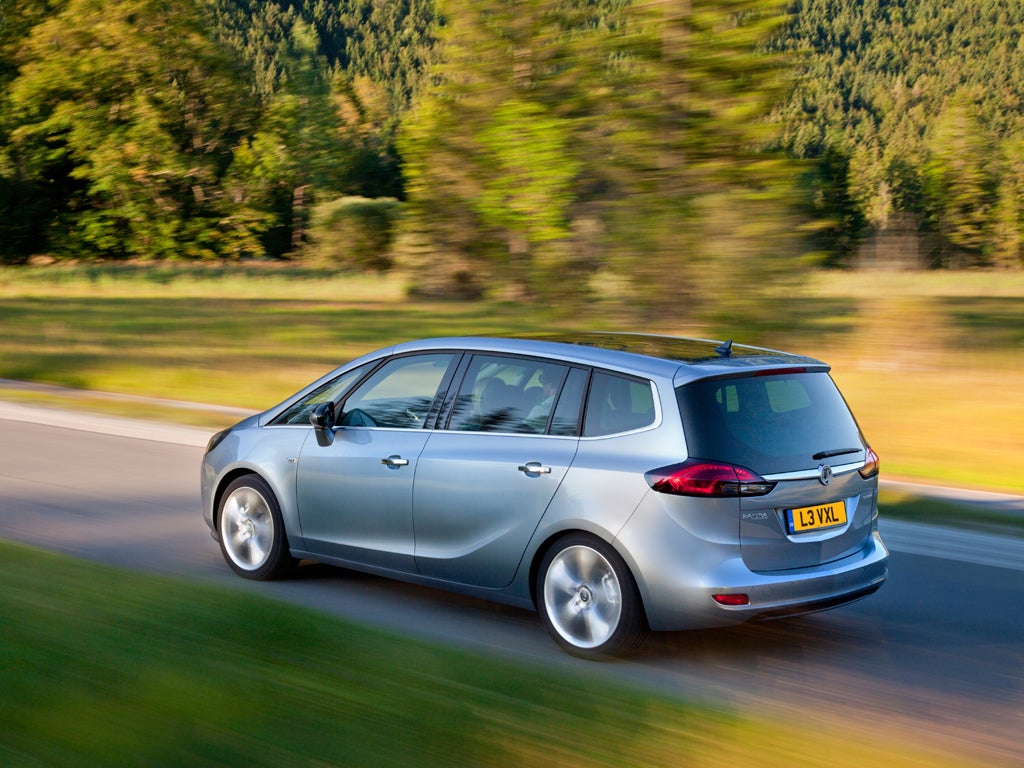Vauxhall Zafira Tourer
The latest version of this popular MPV shows the futuristic flair to be a winner in the space race

Your support helps us to tell the story
From reproductive rights to climate change to Big Tech, The Independent is on the ground when the story is developing. Whether it's investigating the financials of Elon Musk's pro-Trump PAC or producing our latest documentary, 'The A Word', which shines a light on the American women fighting for reproductive rights, we know how important it is to parse out the facts from the messaging.
At such a critical moment in US history, we need reporters on the ground. Your donation allows us to keep sending journalists to speak to both sides of the story.
The Independent is trusted by Americans across the entire political spectrum. And unlike many other quality news outlets, we choose not to lock Americans out of our reporting and analysis with paywalls. We believe quality journalism should be available to everyone, paid for by those who can afford it.
Your support makes all the difference.There is a little bit of the concept car about the new Vauxhall Zafira Tourer.
Those boomerang-shaped front lights and air intakes are what does it, design motifs we have seen on Vauxhall/Opel's show cars but which have not, until now, made it to the production version. They are a brilliant way of disguising the nose-bulk of a modern car.
Actually, there's a lot of bulk-disguising to do on a roomy, seven-seater MPV. Those deep flanks always trouble a car designer; but the new Zafira has some pleasing shaping, with an upward flick to the lower feature line and prominent shoulders flowing into the rear lights. The roof, too, looks like it slopes towards the back more steeply than it does. These things matter if your seven-seater is to avoid looking like a bus.
Inside, stark utilitarianism is equally deftly avoided, although this is actually a very practical cabin with some cleverly conceived features. "Flex" is the keyword here, as in Flex7 (the seat-configuring mechanism) and FlexRail (a triple-layer system of movable containers on rails set between the front seats, for iPods, bottles, handbags, sunglasses and other such life-paraphernalia). The rails even have strips below them that glow red at night.
You might assume, as you read this, that the new Zafira replaces the previous one, but it does not. Not yet, anyway. Instead, the old one finds its range reduced to two models, and it occupies a lower price point, starting at £18,500 rather than the £21,000 required for the cheapest new Tourer. It seems a curious decision, but the idea is to offer both a "basic" seven-seater (the old Zafira) and a grander, more comfortable and more futuristic one (the Zafira Tourer).
So, what do you gain by going for the new one? It looks much better. It has more interior space, thanks to a longer wheelbase. There is a higher-quality feel to the interior, in some ways nudging the notion of "premium" that is every mainstream carmaker's Holy Grail.
And the second-row seats are much more inviting. Previously, there was a single bench which folded on to itself and tipped forward when you wanted to create a clear load bay, but now there are three individual seats. These can be slid back or forth and reclined, or folded flat into the floor, but the SE and top Elite versions also have "lounge" seating. Here, the centre seat folds down and its edges fold further to make the seat narrower. In this condition, the seat's bolsters become armrests for the two outer seats, which slide inwards to meet them and so create more shoulder room.
The rearmost seats also fold flat into the floor for load carrying or to make the boot properly usable. The central-spine roof storage of the old Zafira has gone from the new one, but instead you can have a panoramic windscreen which extends far into the roof.
Under the people-capsule's skin is a combination of parts from the Insignia and the Astra, notably the latter's compact and clever rear suspension. The result is that the Zafira has a smooth, easy ride and there's little need for the optional FlexRide adaptive dampers.
The electric power steering is very anaesthetised and even the most powerful engine, a 165bhp, 2.0-litre turbodiesel, feels no more than quite brisk. Two other engines give 130bhp and a lowly 110bhp, the latter scoring identical CO2 figures to the former's and therefore making itself largely pointless. Two petrol engines are also offered, a 1.4-litre turbo and a naturally aspirated 1.8; both give 140bhp but the 1.8 produces more CO2. Trim levels are ES, Exclusiv (sic), SRi (slightly "sporting"), SE (slightly luxurious) and that top Elite version. Exclusiv, oxymoronically, will be the most popular.
As a motorised domestic appliance of some design flair, the Zafira Tourer hits the spot: it's surely the best-looking of all the seven-seat, relatively compact MPVs, it's quiet and comfortable, and it has lots of the new technology that people think they need. For most buyers, it should prove the ideal family holdall.
The Rivals
Citroën Grand C4 Picasso 2.0 HDI Exclusive: £24,005, 150bhp, 154g/km
Lacks Zafira's styling flair; functional but well-equipped MPV, dull to drive but popular.
Ford Grand C-Max 2.0 TDCi Titanium: £22,745, 140bhp, 139g/km
A bit smaller than Zafira and feels much more agile. Sliding rear doors give awkward looks but practical entry.
Renault Grand Scenic 1.6 dCi 130 Dynamique: £22,200, 130bhp, 115g/km
Re-skin of previous model, well-finished cabin and comfortable ride. New engine gives great economy.
Join our commenting forum
Join thought-provoking conversations, follow other Independent readers and see their replies
Comments